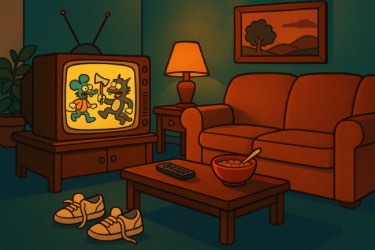Matt Groening’s work sits at that perfect crossroads of satire and heart. If you were like me, you may remember racing home after school to catch syndicated episodes, then gathering on Sunday nights when a yellow-hued family reset the week with a couch gag and a wink. Years later, you can still spot his influence at conventions: T-shirts, quotes traded in line, and that feeling that animation can be both silly and razor sharp.
The Signature Voice: Satire with a Pulse
Groening’s worlds tease power, poke at pop culture, and still make space for tenderness. The jokes hit fast, but what lingers are the choices: a pause before a punchline, an eye dart that sells a thought, a rhythm that turns gags into character. It’s comedy as character study, not just noise.
The Simpsons: A Living Laboratory of Timing
From chalkboard gags to couch gags, the show became a weekly masterclass in setup and payoff. Watch how scenes breathe: a one-beat stare, a two-beat sigh, then a left-turn tag. The silhouette reads instantly; the performance pays it off; the timing is the bridge between. The secret isn’t just jokes—it’s clarity.
Futurama: Hearts in a Sci-Fi Wrapper
Futurama swaps cul-de-sacs for cryo tubes, but the engine’s the same: specificity. Math jokes nest inside slapstick; optimism shares panel space with pathos. A robot gets the human line; a human takes the robot’s logic; your chest tightens anyway. Science fiction turns out to be a great mirror for feelings.
From Living Rooms to Conventions: Why It Resonates
Part of the magic is communal ritual: after-school reruns, Sunday-night premieres, quotes traded in the lunchroom, memes reborn each decade. Another part is repeatable craft: clean silhouettes, truthful micro-expressions, and rhythm you can hum.

That mix—ritual plus craft—explains why fans keep returning, and why new generations find a way in.
What Creators Can Steal (Respectfully)
- Lead with silhouette. If the outline reads, the joke lands cleaner.
- Use the beat. A two-count pause can be the whole laugh.
- Write specific, stage universal. A donut is a donut; it’s also comfort, habit, and reset.
- Build running gags. Repetition isn’t laziness if you escalate or subvert.
- Let heart cut the snark. A single sincere line can anchor ten jokes.

Take those five and you can bolt satire to sincerity—your characters will feel bigger than the punchlines they deliver.
Want to reverse-engineer timing, beats, and gag escalation with guided exercises?
Final Thoughts
Groening’s legacy isn’t one show or even two—it’s a way of balancing bite with warmth. If you’re building your own world, let your characters mean something, then let them be funny about it. The laughs last longer when the feelings do, too.




























